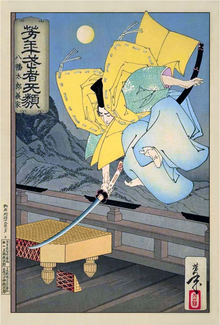Minamoto no Yoshiie

Template:Japanese name Minamoto no Yoshiie (源 義家; 1039 – 4 August 1106), also known as Hachimantarō, was a Minamoto clan samurai of the late Heian period, and Chinjufu shogun (Commander-in-chief of the defense of the North). The first son of Minamoto no Yoriyoshi, he proved himself in battle with the Abe clan in the Zenkunen War (Early Nine Years' War) and the Kiyowara clan in the Gosannen War (Later Three Years' War). Subsequently, he became something of a paragon of samurai skill and bravery.
The Zenkunen War
In 1050, Abe no Yoritoki held the post of Chinjufu shogun, as the Abe clan had for many generations; he was the chief commander of the defense of northern Honshū against the native Ezo (Ainu) people. Effectively, however, Yoritoki commanded the entire region, denying the official Governor any true power. As a result, Yoshiie's father was appointed both chinjufu shogun and governor, and Yoshiie traveled north with him to resolve the situation.
The campaign against the Abe clan lasted twelve years (nine, with three years truce). Yoshiie fought alongside his father in most if not every battle. Abe no Yoritoki died in 1057, but his son Abe no Sadato took up command of his father's forces.
The fighting culminated in 1062, in a series of actions that further enhanced Yoshiie's reputation. Abe no Sadato had attacked the Minamoto forces but, suffering a reversal, retreated into a fort near the Kuriya River. Yoriyoshi ordered a spirited assault on the fort, and set it aflame, forcing Sadato to flee. During the chaotic retreat, Yoshiie was supposed to have chased Sadato and had an impromptu renga (linked verse) session with his enemy from horseback, afterwards allowing him to escape, as related in the Mutsu Waki (The Story of Mutsu):
Yoriyoshi's first son, Hachimantarō, gave hot pursuit along the Koromo River and called out, 'Sir, you show your back to your enemy! Aren't you ashamed? Turn around a minute, I have something to tell you.' When Sadato turned around, Yoshiie said:
Koromo no tate wa hokorobinikeri ("Koromo Castle has been destroyed." or, alternatively, "The warps in your robe have come undone.")
Sadato relaxed his reins somewhat and, turning his helmeted head, followed that with:
toshi o heishi ito no midare no kurushisa ni ("Over the years its threads became tangled, and this pains me.")
Hearing this, Yoshiie put away the arrow he had readied to shoot, and returned to his camp. In the midst of such a savage battle, that was a gentlemanly thing to do.[1]
Yoshiie returned to Kyoto in early 1063 with the heads of Abe no Sadato and a number of others. As a result of his dramatic prowess in battle, he earned the name Hachimantarō, referring to him as the son of Hachiman, the god of war. The following year, Yoshiie took several followers of the Abe, who he had taken as captives, as attendants.
The Gosannen War
Over twenty years later, Yoshiie was the chief commander in another important conflict of the Heian period. Beginning in 1083, he battled the Kiyowara family, who had fought alongside him and his father against the Abe, but who had since proven themselves poor rulers of the northern provinces.
Named Governor of Mutsu province in 1083, Yoshiie took it upon himself, without orders from the Imperial Court, to bring some peace and order to the region. A series of disputes between Kiyowara no Masahira, Narihira, and Iehira over leadership of the clan had turned to violence.
There emerged a series of battles and skirmishes between Yoshiie's forces and those of the various Kiyowara sub-factions. Everything came to a head in 1087, at the Kanazawa stockade. Yoshiie, along with his younger brother Minamoto no Yoshimitsu and Fujiwara Kiyohira, assaulted the position held by Kiyowara no Iehira and his uncle Kiyowara no Takahira. After many months of failed starts and skirmishes, the stockade was set aflame, and the Kiyowara defeated; Takahira and Iehira were killed. The Minamoto forces suffered great losses as well, and it is said that Yoshiie was an especially skilled leader, keeping morale up and preserving a degree of discipline among the warriors.
See also
References
- Sansom, George (1958). 'A History of Japan to 1334'. Stanford, California: Stanford University Press.
External links
